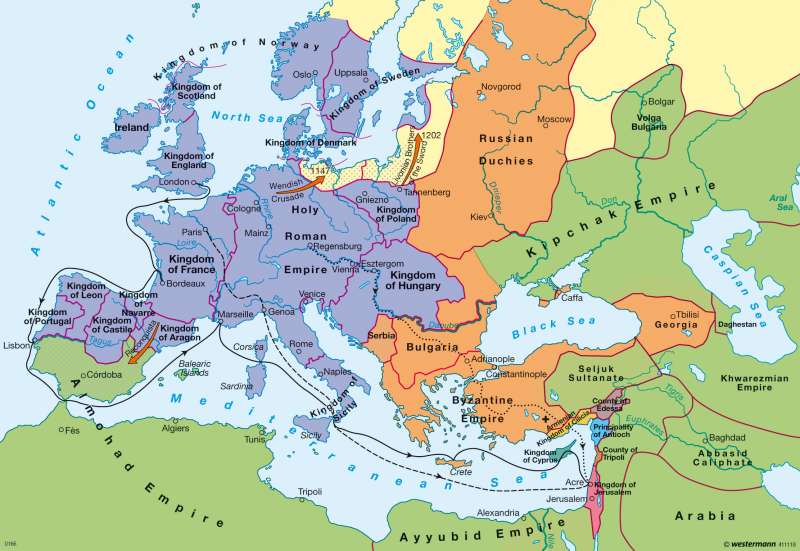Europe during the first crusades in the late 12th century
Europe - Middle Ages
978-3-14-100790-9 | Page 30 | Ill. 2

Information
Christianity was firmly established nearly everywhere in Europe by 1200 AD. Following the conquest of Spain by the Moors in the 8th century, however, Islam had spread to North Africa, the Middle East, Central Asia and, in the 11th century, to India as well. Thus Europe was bordered to the east and south by Islamic regions, and the "Holy Land" of Palestine was firmly under Islamic rule.The Crusades
Following Byzantine Emperor's call for help in the war against the Turkish Seldshuks, Pope Urban II issued an appeal to all Christians to wage a Holy War for the "liberation" of Jerusalem in 1095. Incensed crowds invaded the Jewish quarters of cities in France and Germany, murdering and plundering. On their first campaign to the Holy Land, the Crusaders were soundly defeated by the Seldshuks, however. The First Crusade was launched a year later. Several Crusader states were established: the Kingdom of Jerusalem and the principalities of Edessa, Antioch and Tripoli. The reconquest of Edessa by the Seldshuks in 1146 led to the Second Crusade, which ended in a military disaster on the march through Asia Minor.
The occupation of Jerusalem by Sultan Saladin triggered the Third Crusade. Led by Emperor Frederick Barbarossa, King Philipp II of France and Richard the Lionheart of England, an impressive army embarked from Europe to liberate Jerusalem. The Emperor, who chose to move his troops overland, drowned in a river in Asia Minor in 1190. Richard the Lionheart went by sea and took Cyprus. In 1191, he succeeded in conquering Acre after a lengthy siege and proceeded to secure a narrow strip of land along the coast between Tyros and Jaffa. The kingdom was proclaimed there once again.
The following three Crusades either failed before reaching their destination or yielded little success. The Seventh Crusade of 1248 is regarded as the last great European effort to come to the aid of the Crusader states. Although Acre was reinforced and held until its final fall in 1291, Jerusalem and the Holy Sites were lost. Yet the spirit of the Crusades had spread throughout Europe. In the name of the Christian cross, forces attacked the heretical Albigensians in southern France, the heathen Prussians and Estonians in the Baltic region and the Arab rulers on the Iberian Peninsula.
Background of the Crusade movement
The Crusade movement from the 11th to the 13th centuries is attributable not only to religious causes, but to social, demographic, political and economic influences as well. The vehement Western European response to the spectacular conquests of the Seldshuks in the distant Christian East was above all a reflection of the fact that Christianity had established a strong foothold in daily life as a result of the increasing population density in European villages and cities.
Social and demographic factors had an equally strong impact on the Crusade movement. The growth of the feudal system had created social tensions in many European countries. Population growth in the 11th century had rendered many farmers and a number of minor nobles landless, a circumstance that unleashed a major wave of migration. The Crusades were motivated not least of all by economic interests. The establishment of urban settlements under the protection of feudal lords at monasteries, crossroads and bridges promoted the growth and expansion of trade.
One of the goals of the Crusades, the unification of the Roman and Byzantine churches, was not achieved. Yet contact with Byzantium and the Islamic world established the prerequisites for the introduction of Greek philosophy to the Occident. Furthermore, the trade routes of the Venetians and Genoans were secured.
K. Lückemeier, E. Astor; Ü: Southard




